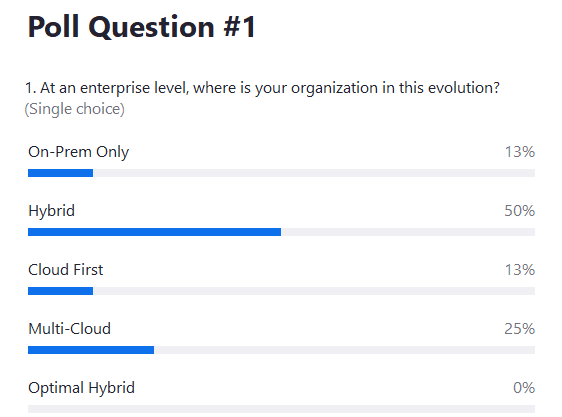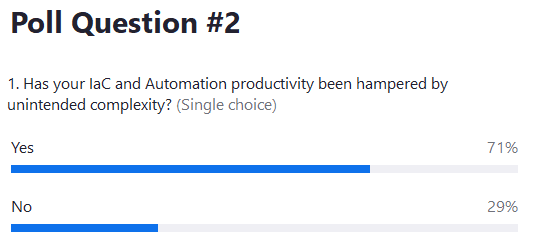CIO Fireside Chat Recap: Hybrid IT Using IaC and Automation

In our recent Blue Mantis CIO Fireside Chat, a panel of industry veterans explored the intersection of hybrid cloud architecture, infrastructure as code, and automation in the modern enterprise. The panel featured Roger McIlmoyle, a leader in cloud technology engineering with three decades of experience, who now leads Blue Mantis’ Infrastructure Automation and DevOps teams, along with Mick Scott, a respected consultant with solutions architect certifications for both AWS and Microsoft Azure cloud technologies. I’m Chris Toushan, VP and GM of Blue Mantis Canadian Operations, and I was both panel moderator and the voice of the business executive when it comes to discussing the challenges faced and benefits sought by CIOs in enterprise IT.
The Evolution and Benefits Hybrid IT Architecture
After a brief discussion on the evolution of cloud computing, our panelists delved into the idea of how most companies operate in a hybrid cloud environment today. Because so few organizations have their IT stack in an either pure public cloud or a pure on-prem data center environment, the discussion underscored the importance of a strategic approach to cloud adoption. Roger talked about two complementary aspects of this strategic approach:
- Strategic Workload Placement: Roger emphasized that not all workloads are perfectly suited for the public cloud. The decision on where to place workloads—whether on-premises or in the cloud—should be driven by factors such as performance requirements, cost considerations, and regulatory compliance. It was Roger’s view that strategic workload placement is something that CIOs should focus on when it comes to hybrid cloud architecture, because it enables organizations to leverage the best of both worlds.
- Standardization and Automation: Another key aspect of managing hybrid cloud environments discussed was standardization and automation. Wherever workloads are strategically placed in the hybrid IT environment, standardizing and automating operations is essential for ensuring consistency, reducing complexity, and enabling scalability. By automating routine tasks and standardizing environments, CIOs can improve their organization’s efficiency and agility.
As many CIOs have already surmised, balancing on-premises with cloud resources optimizes their overall operational efficiency and cost-effectiveness. To achieve that balance, many CIOs are turning to infrastructure as code to provision and manage their data center resources.
Infrastructure as Code (IaC) and Automation
Infrastructure as code or IaC, combines virtualization with descriptive programming files to provision and manage your computing infrastructure. During the panel discussion, Roger pointed out there is a critical distinction between automation and IaC, and those differences underscore each aspect’s importance in efficiently managing workloads in a hybrid setting. One of the ways IaC is distinguished from traditional automation, is that IaC focuses on deploying infrastructure through code, enabling predictable, scalable, and efficient management of IT resources. This approach has evolved to support both virtual and physical servers, emphasizing declarative and imperative methods for infrastructure deployment.
The benefits of IaC such as version control, dynamic scalability, and simplified resource management are crucial for achieving economic value in the cloud. When infrastructure can be deployed and managed with precision and efficiency, it eliminates much of the costly guesswork required to procure and configure data center resources physically. However, the panel didn’t shy away from the challenges of “unintended complexity” and vendor lock-in that can arise with IaC. Roger suggested a strategic approach to tool selection and governance to mitigate these risks, emphasizing the importance of choosing tools that avoid vendor lock-in and support multi-cloud and hybrid IT strategies.
Mick agreed with Roger’s assessment, noting that automation was more about workflow orchestration and enabling IT operations to be more predictive and monitored after IaC was deployed. Automation is often combined with IaC, deploying infrastructure through code, which allows for scalable and dynamic resource management. This combination is pivotal for achieving economic value in the cloud by enabling scalability and dynamic adjustments to resource utilization. This combination of automation and IaC is crucial to any CIO’s hybrid IT strategy to maintain service consistency and reliability.
Checking the Pulse of the CIO via Poll Results
During the CIO Fireside Chat, we conducted two audience polls. The first poll revealed that nearly 50% of participants are in a hybrid scenario, maintaining both on-premises and cloud infrastructures but not necessarily adopting a cloud-first strategy. This reflects a broader trend where about 70% of organizations are between hybrid and cloud-first stages. Interestingly, none of the participants responded affirmatively when asked if their IT organization had achieved an “Optimal Hybrid” state yet:

Our second poll indicated that 70% of respondents experienced unintended complexity due to IaC and automation, highlighting the challenges of managing these technologies effectively. This led to the panelists sharing their strategies for assessing current IT environments, consolidating tooling, and implementing governance to navigate these challenges effectively:

These poll results show that many IT leaders are still struggling to achieve the optimal balance between on-premises and cloud infrastructures.
Achieve your optimal hybrid IT state with Blue Mantis
To overcome these challenges and accelerate the digital transformation journey. Blue Mantis can help you design, implement, and manage a hybrid IT architecture that meets your business needs and aligns with your cloud strategy. We can also help you adopt best practices for IaC and automation, enabling you to deliver faster, safer, and more reliable outcomes. If you want to learn how Blue Mantis can help your organization achieve an Optimal Hybrid state, contact us today for a free consultation.




